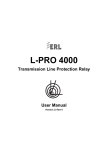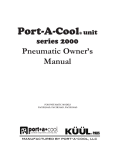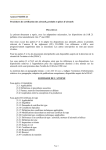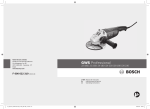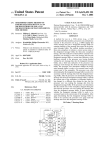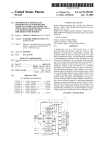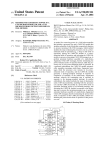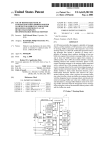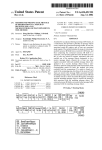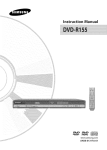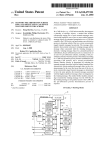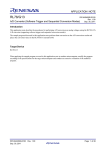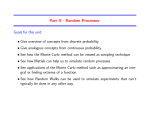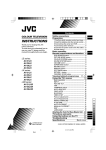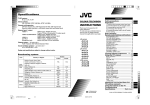Download End-of-message handling and interrupt generation in a CAN module
Transcript
US006647440B1
(12) United States Patent
(10) Patent N0.:
(45) Date of Patent:
Birns et al.
(54) END-OF-MESSAGE HANDLING AND
(75)
WO
......... .. G06F/ 13/00
Inventors: Neil Edward Birns, Cupertino, CA
ACAN microcontroller that supports a plurality of uniquely
(57)
Notice:
ABSTRACT
numbered message objects, that includes a processor core
that runs CAN applications, a plurality of message buffers
associated With respective ones of the message objects, and
a CAN/CAL module. The CAN microcontroller further
includes a plurality of individual message object registers
associated With each message object, including at least one
(73) Assignee: Koninklijke Philips Electronics N.V.,
Eindhoven (NL)
control register that contains an interrupt-enable control bit,
Subject to any disclaimer, the term of this
patent is extended or adjusted under 35
microcontroller also includes a plurality of global message
object control registers, including at least one message
complete status register that contains a plurality of status
?ag bits for respective ones of the message objects, at least
one interrupt ?ag register that contains a receive complete
a receive enable bit, and a transmit enable bit. The CAN
U.S.C. 154(b) by 398 days.
This patent is subject to a terminal dis
claimer.
interrupt ?ag bit and a transmit complete interrupt ?ag bit,
and a message complete info register that contains a plural
ity of message object identi?cation bits and a status bit. The
CAN/CAL module includes a message handling function
that automatically transfers successive frames of an incom
ing multi-frame message to the message buffer associated
With a corresponding message object; an end-of-message
detection function that detects an end-of-message condition
Which occurs When the last frame of the accepted incoming
multi-frame message has been stored in the message buffer
(21) Appl. No.: 09/630,288
Aug. 1, 2000
(22) Filed:
Related US. Application Data
(60)
Provisional application No. 60/154,022, ?led on Sep. 15,
(51)
(52)
Int. Cl.7 .............................................. .. G06F 13/14
1999.
US. Cl. ....................... .. 710/29; 379/133; 370/470;
associated With the corresponding message object; and, an
709/238
end-of-message detection handling and interrupt generation
Field of Search ......................... .. 710/29; 379/133;
function that, in response to the detection of the end-of
message condition: sets the status ?ag bit contained in the at
least one message complete status register associated With
370/470; 709/238
References Cited
(56)
the corresponding message object; sets the receive complete
interrupt ?ag bit contained in the at least one interrupt ?ag
register, if the interrupt-enable control bit contained in the at
U.S. PATENT DOCUMENTS
4,127,742 A
4,604,682 A
least one control register associated With the corresponding
message object is set; and, sets the status bit contained in the
message complete info register, if the interrupt-enable con
trol bit contained in the at least one control register associ
ated With the corresponding message object is set.
* 11/1978 Couturier et a1. ..... .. 179/18 FC
8/1986 Schwan et al. ........... .. 364/200
(List continued on neXt page.)
FOREIGN PATENT DOCUMENTS
DE
GB
3/ 1984
Primary Examiner—Abdelmoniem Elamin
(Us)
(58)
*Nov. 11, 2003
INTERRUPT GENERATION IN A CAN
MODULE PROVIDING HARDWARE
ASSEMBLY OF MULTI-FRAME CAN
MESSAGES
(US); William J. Slivko?', San Jose,
CA (US); Hong Bin Hao, San Jose, CA
(US); Richard Fabbri, Stamford, CT
(US); J ie Zheng, Mountain View, CA
(*)
WO8400836
US 6,647,440 B1
4340219 A1
2293470 A
6/1995
3/1996
........... ..
GO6F/9/46
........... ..
GO6F/9/44
31 Claims, 7 Drawing Sheets
/20
34
CORE DATA BUS E
24
XA CPU CORE
I 22
PROGRAM BUS
32K mas
ROM/EPROM
25
DAT
BUS
1024BYTES
DAIARAM
27
EXIEBML
ADDRiSSI
DATA BUS
H
28
XRAM
mm“
INTERFMIE
32
CURE
I
7‘ ER
‘ v77
4-
PORIS 0-3
61
55
US 6,647,440 B1
Page 2
US. PATENT DOCUMENTS
*
3/1999 Bement et a1. ........... .. 370/389
364/200
6,363,083 B1 **
3/2002 Spielbauer et a1. ....... .. 370/470
9/1994 Kaneko ~~~~~~ “
395/725
6,529,594 B1
3/2003
11/1995 Shimizu et al.
395/375
4802
089 A
,
,
1/1989 Sh aw
5,349,667 A
5,471,620 A
5,530,597 A
5,881,063 A
....................... ..
6/1996 Bowles et a1. ............ .. 395/735
* cited by examiner
Brockman et a1. ........ .. 379/133
U.S. Patent
Nov. 11, 2003
US 6,647,440 B1
Sheet 1 0f 7
_
STANDARD
8w SUE CANJD
EOF
mm Hm 114m
Bus Idm
1-bit ms ms
5E s05 BaselD
cac
ACK AGK'
Idle 14m ?-MSBs
1m
Hm
EXTENDED
RIB RmnteTransmiiRequesl
SHR SubstiMeRemuteRequesl
IDE 10 Extension
r1, r0 ‘reserved’ bits
DLC DataLengthCode (0.1. a)
IFS lnterfm
CAN.bus
B-Byte
. . .C.A.L1“§5“.;9E“§.. .
CAN
Data
I I ‘C
- - -.
- - --- . -|
W
3.3”‘;
"WW5 . .
. . . . . . . . . . . . . . . ... ....... ..
3.5m
U.S. Patent
Nov. 11,2003
Sheet 2 0f 7
US 6,647,440 B1
20
........................................
5
5
34
CORE DATA Bus
1
5
5
2 >
XA CPU 0on5
;
PROGRAM BUS
24x 32K ewes
;
ROM/EPROM
E
26.\_ 1024 BYTES
'
EXTEF'INAL
DIATABUSI MEMmY
32 :i
E
1
XRAM
x23
36
0
Tx<-——-———'-
L
1
CORE
L
" """"""
SP1
g;
I: '
/-L—%'*>51
<~,—
,1»
"’
mamo ‘
:j
T‘MER2 4,
Rx_}--_-_-q'>
;
:
42] 2.08 CAN/DLL ‘I, I
i
4+ UART 0
5
g
:
:
27
MMR BUS
i
;
2
A
l- - . . - EggggE
- - - - - - - - 4L...
H
41
BUS
DATA RAM
4.,
ADDRESS!
i
:
:
5F“ BUS
DAT
;
;
A
x43
;
~22
WATCHDOG
0 “Mm
‘~77
:
H
:
:
g
55
E
<-:.-———-> PORTS 0-3 <-—-->
i ......... "01f. .................... -1 ............
;
U.S. Patent
Nov. 11,2003
;
Sheet 3 0f 7
US 6,647,440 B1
MMRs
MMRname lR/W? I Reset
[Access jAddressOttset
MesseqeObjed Registers (n=0- 31)
lDeseriprien
MnMtDH
HM
x...x00b
Word onty
000mm (n?h) Message 0 Match ID High
Mat/80L
2W
XtOOth
Word only
tmmrgmre??ttth (02h) Message 0 Match ID Low
MnMSKH
MnMSKL
MnCTL
BM
BM
R/W
x..x000h Wordonty
mom
Wont only
000mm Byte/Word
rg0100h(n4h) Messagen Maskttigh
wttnengngmngmteb (n81) MessagenMaskLon
tt??rwrgngnmtwttbmttht Messagencomrol
MnBLR
IW
XXtOth
tmrwlgnznrmt 0100 (Mb) Message n Butter Lerztien
MnBSZ
RM
0mm ByteMerd
wewgr?mwoemcnt MessagenBu?er Size
MnFCR
B/W
wmnxxh Byte/Word
omwlmmmonneg MessagenFmrrentation Count
Word enly
CIC Registers
MCPU.
Hit)
000%
Word
24!!
Massage Cempletetew
MCPLH
CANtNTFLG
MCIR
MEIR
FESTR
RIC
RIC
R0
R0
RIC
00000
Otttt?h
0000b
0000h
0000b
Byte/Word
BytelWerd
ByteMord
ByreMerd
Byte/Ward
2260
221th
22%
22Ah
220k
Message CompleteHigh
CAN lntenuptFtagRegtster
Message Complete tnte Reg.
Masage Errorlntottegister
Frane Error Status Register
FEENR
R/W
0000b
Byte/Word
2281
Frame Error Enahte Register
SOP/SP! Registers
Bytemord 26m
SPICFG
R/W
{D001
SCP/SPICnnttguratinn
SPtDAtA
SPtCS
R/W
R/W
(1th
00h
Byteiword
2620
@Word 2630
0C8 Registers
SCP/SPI Data
SOP/SH Controtand Stahrs
CANCMR
CANSTH
CANBIB
BIW
BIO
BM
0th
00h
00h
Byte/Nerd
Byte/Word
More
2101
27th
272i]
CANComrnand Register
CANStatus Register
CAN BusTiming Reg. (tote)
-
R/W
00h
Byte/Word
271th
CNtBusTiming Reg. (high)
TXEBC
RXERC
EWUt
81W‘
RM‘
RM
00h
001
961
Byte/Worn
Byte/Word
Byte/Word
274k
275h
275h
Tx Error Counter
RxError Ceunter
Enor Warning Limitttegiste
ECCR
R0
name
Byte/Word
2780
Errer?ode Capture Register
ALCR
RTXDTM
R0
W0
001th
omen
Byte/Word
ByteNlont
271th
27Ch
Arbitration Lest Capture Reg.
BTXDataTest Mode
GCTL
BM
M00
B?elword 2781
Mt? Registers
Global Control Byte
Byte/Word
XRAMBaseAddm
XHAMB
IW
FEh
MBXSH
MFBTRL
MFBTRH
RM
BM
RM
FFtr
EFh
FFh
2900
Byte/Word 29th
MsgBuft/XRAM Segtteg.
Byte/Word 2920
MIF Bust‘rming Region
ByteMord 293h
MtF Busttming ?eg?gr
Legend: R/W = Read 8. Write, R0 = Read Only, W0 zwme My’ NC : Read & cm‘ w = Writabte onty during
G 4
CAN Reset mode, x = unde?ned after reset
U.S. Patent
US 6,647,440 B1
Sheet 4 0f 7
Nov. 11,2003
Data Memory Segment 0
OOFFFFh
.LLLLLLLI
Off-Chip
4K Bytes
MMR Space
EFI'I'IT'IT
MMR Base Address
Off-Chip
512 BytesT
XRAM
[11:131-11
XRAM Base Address
Off-Chip
0003FFh .IlLUILIJ
O?-Chip Data Memory
(Scratch Pad)
ITI'ITIIF
00000011
FIG. 5
MMR Space
Offset F FFh ———>
O?set 1FFh ——>
512 Bytes Object Registers
4- O?set 0000
FIG. 6
U.S. Patent
Nov. 11,2003
Sheet 5 0f 7
US 6,647,440 B1
Segment xy in Data
Memory Space
xyFFFFh ______l
Objggt "T Object 0 Message Butter
Buffer size
a23
:06 as
|'__ <—- MBXSRITIOI
an
MnBLR
XRAM
5128088
a23
a16a15
|——— <- maxsmml
a8a7
XRAMBWIO
a0
00h
|____ xy0000h
FIG. 7
Segment xy in Data
Memory Space
xyFFFFha_.___J
a23
a16 :05
4- MBXSRlT?l
a0
MnBLR
{mint Obiect 0 Message Buffer
XRAM
512 [M85
Bmfersize
'
XRAM
323
,--1———
FIG. 8
316 815
38 a7
maxsmml mAMBmm?L 000
30
U.S. Patent
Nov. 11,2003
Sheet 6 OH
US 6,647,440 B1
Object 0 Match ID Field (M?MiDH and MnMlDL)
Midi
MidQ - Mid2
Mid17 - MidiO
MidZB — Mid18
MidO
MIDE
Obieci n Mask Field (MnMSKH and MnMSKL)
MSk28 — MSi?B
MSki? - M5k10
MskQ — Msk2
Mski
MskO
Screener iU Field (assembled from incoming bit-stream)
CAN i028 - CAN 10.18
Data Byte 1 [7:0] Data Byte 2 [7:0]
X
X
IDE
FIG. 9
Obiect n Match ID Fieid (MnMIDH and MnMlDL)
MidZB — Mid18
Mid17 - Mid10
Mid9 — MidZ
Midi
Midi) MIDE
Obieci n Mask Field (MnMSKH and MnMSKL)
Msk28 — MskiB
Mski 7 — MskiO
MskD
Screener iD Field (assembled from incoming bit-stream)
CAN i028 — CAN |D.0
FIG. 10
IDE
U.S. Patent
Nov. 11,2003
B0
Data Byte 2
Data Byte 3
Sheet 7 0f 7
‘1102000
ADDRESS
Data Byte DLC
Data Byte 2 (next)
Data Byte 3 (next)
1:16.11
Ftamelnfo
Data Byte‘
Data Byte 2
Data Byte DLC
Framelnto (next)
Data Byte 1 (next)
Data Byte 2 (next)
F1G.12
DIRECTION OF
INCREAStNG
ADDRESS
US 6,647,440 B1
US 6,647,440 B1
1
2
END-OF-MESSAGE HANDLING AND
INTERRUPT GENERATION IN A CAN
MODULE PROVIDING HARDWARE
ASSEMBLY OF MULTI-FRAME CAN
MESSAGES
member of the Philips XA (eXtended Architecture) family
of high performance 16-bit single-chip microcontrollers. It
is believed that the XA-C3 is the ?rst chip that features
hardWare CAL support.
The XA-C3 is a CMOS 16-bit CAL/CAN 2.0B micro
controller that incorporates a number of different inventions,
including the present invention. These inventions include
This application claims the full bene?t and priority of
US. Provisional Application Serial No. 60/154,022, ?led on
Sep. 15, 1999, the disclosure of Which is fully incorporated
novel techniques and hardWare for ?ltering, buffering,
handling, and processing CAL/CAN messages, including
herein for all purposes.
the automatic assembly of multi-frame fragmented mes
sages With minimal CPU intervention, as Well as for man
BACKGROUND OF THE INVENTION
The present invention relates generally to the ?eld of data
communications, and more particularly, to the ?eld of serial
communications bus controllers and microcontrollers that
incorporate the same.
aging the storage and retrieval of the message data, and the
memory resources utiliZed therefor. In particular, the XA-C3
CAN module has the unique ability to track and reassemble
15
in hardWare, only interrupting the CPU (processor core)
once a complete, multi-frame message is received and
CAN (Control Area Network) is an industry-standard,
assembled. This tremendously reduces the processor band
tWo-Wire serial communications bus that is Widely used in
Width required for message handling, thereby signi?cantly
automotive and industrial control applications, as Well as in
increasing available bandWidth for other tasks, so that sys
medical devices, avionics, office automation equipment,
tem performance is greatly enhanced.
The present invention relates to the techniques employed
consumer appliances, and many other products and appli
cations. CAN controllers are currently available either as
stand-alone devices adapted to interface With a microcon
troller or as circuitry integrated into or modules embedded
in a microcontroller chip. Since 1986, CAN users (softWare
the packets constituting a fragmented message, completely
by the XA-C3 microcontroller for detecting an end-of
25
message condition, for end-of-message handling, and for
generating the appropriate end-of-message interrupt.
Fundamentally, the task of responding to the end of a
programmers) have developed numerous high-level CAN
Application Layers (CALs) Which eXtend the capabilities of
message should be very straightforWard. More particularly,
the CAN While employing the CAN physical layer and the
CAN frame format, and adhering to the CAN speci?cation.
CALs have heretofore been implemented primarily in
softWare, With very little hardWare CAL support.
Consequently, CALs have heretofore required a great deal of
the ?nal frame of the message should be stored in the buffer,
an interrupt to the processor should be generated, and the
host CPU intervention, thereby increasing the processing
complicated in the XA-C3 microcontroller, since the XA-C3
CAN module can concurrently assemble many (up to 32)
overhead and diminishing the performance of the host CPU.
softWare should respond by retrieving the message data from
the buffer.
HoWever, this seemingly fundamental task is greatly
35
Thus, there is a need in the art for a CAN hardWare
incoming, fragmented messages of varying lengths,
implementation of CAL functions normally implemented in
Whereby up to 32 completed messages can be staged and
Waiting by the time the processor responds to the initial
softWare in order to offload these tasks from the host CPU
to the CAN hardWare, thereby enabling a great savings in
end-of-message interrupt, i.e., the interrupt issued in
host CPU processing resources and a commensurate
response to completion of the ?rst received complete mes
sage. A further complication arises by virtue of the fact that
it is often appropriate for the softWare to “poll” certain
improvement in host CPU performance. One of the most
demanding and CPU resource-intensive CAL functions is
message management, Which entails the handling, storage,
categories of messages on an occasional basis rather than
and processing of incoming CAL/CAN messages received
over the CAN serial communications bus and/or outgoing
45
CAL/CAN messages transmitted over the CAN serial com
munications bus. CAL protocols, such as DeviceNet,
Way, the softWare must be able to determine at any time
Whether a complete message is available for all message
CANopen, and OSEK, deliver long messages distributed
over many CAN frames, Which methodology is sometimes
referred to as “fragmented” or “segmented” messaging. The
process of assembling such fragmented, multi-frame mes
sages has heretofore required a great deal of host CPU
intervention. In particular, CAL softWare running on the host
CPU actively monitors and manages the buffering and
processing of the message data, in order to facilitate the
assembly of the message fragments or segments into com
respond to an end-of-message interrupt at the moment
messages Within one of these categories completes. This
implies that some message objects may be set up to generate
an end-of-message interrupt, While others are not. Either
objects. Further, When an end-of-message interrupt is
asserted, the processor must be able to determine quickly
and easily Which message or messages are complete, i.e.,
ready for processing.
In designing the XA-C3 microcontroller, the present
55
inventors contemplated and rejected a number of message
plete messages.
complete handling schemes, because these schemes Would
have required extremely cumbersome, inef?cient softWare
Based on the above and foregoing, it can be appreciated
that there presently eXists a need in the art for a hardWare
code, and/or Would have added far too much die area. The
present invention, as described beloW, Was conceived and
implementation of CAL functions normally implemented in
?nally adopted as the optimum approach.
softWare in order to offload these tasks from the host CPU,
thereby enabling a great savings in host CPU processing
resources and a commensurate improvement in host CPU
performance.
The assignee of the present invention has recently devel
oped a neW microcontroller product, designated “XA-C3”,
that ful?lls this need in the art. The XA-C3 is the neWest
SUMMARY OF THE INVENTION
The present invention encompasses a CAN microcontrol
ler that supports a plurality of uniquely-numbered message
65 objects, that includes a processor core that runs CAN
applications, a plurality of message buffers associated With
respective ones of the message objects, and a CAN/CAL
US 6,647,440 B1
3
4
module. The CAN microcontroller further includes a plu
message complete info register is enabled, until the status
?ag bit is no longer enabled.
The CAN/CAL module generates a message-complete
rality of individual message object registers associated With
each message object, including at least one control register
that contains an interrupt-enable control bit, a receive enable
bit, and a transmit enable bit. The CAN microcontroller also
interrupt in response to detection of an end-of-message
condition if the interrupt-enable control bit contained in the
at least one control register associated With the correspond
ing receive-enabled message object is enabled. The current
includes a plurality of global message object control
registers, including at least one message complete status
register that contains a plurality of status ?ag bits for
application running on the processor core processes the
respective ones of the message objects, at least one interrupt
?ag register that contains a receive complete interrupt ?ag
completed message, in response to the message-complete
10
bit and a transmit complete interrupt ?ag bit, and a message
complete info register that contains a plurality of message
BRIEF DESCRIPTION OF THE DRAWINGS
object identi?cation bits and a status bit.
The CAN/CAL module includes an acceptance ?ltering
function that performs acceptance ?ltering on each
incoming, multi-frame message by comparing a screener
?eld of the incoming, multi-frame message With an accep
tance ?lter ?eld associated With each message object Which
has its associated receive enable bit set, Wherein the
incoming, multi-frame message is accepted if its screener
?eld matches the acceptance ?lter ?eld of a receive-enabled
message object; a message handling function that automati
cally transfers successive frames of an accepted incoming
15
FIG. 2 is a diagram illustrating the interleaving of CAN
Data Frames of different, unrelated messages;
FIG. 3 is a high-level, functional block diagram of the
25
FIG. 5 is a diagram illustrating the mapping of the overall
data memory space of the XA-C3 microcontroller;
FIG. 6 is a diagram illustrating the MMR space contained
Within the overall data memory space of the XA-C3 micro
controller;
detection of the end-of-message condition: sets the status
?ag bit contained in the at least one message complete status
register corresponding to the matching receive-enabled mes
35
contained in the at least one interrupt ?ag register, if the
interrupt-enable control bit contained in the at least one
control register associated With the matching receive
enabled message object is set; and, sets the status bit
contained in the message complete info register, if the
interrupt-enable control bit contained in the at least one
FIG. 7 is a diagram illustrating formation of the base
address of the on-chip XRAM of the XA-C3
microcontroller, With an object n message buffer mapped
into off-chip data memory;
FIG. 8 is a diagram illustrating formation of the base
address of the on-chip XRAM of the XA-C3
microcontroller, With an object n message buffer mapped
into the on-chip XRAM;
FIG. 9 is a diagram illustrating the Screener ID Field for
a Standard CAN Frame;
control register associated With the matching receive
FIG. 10 is a diagram illustrating the Screener ID Field for
enabled message object is set.
an Extended CAN Frame;
A current application running on the processor core can
check the status of the status ?ag bits contained in the at least
one message complete status register, at selected times. The
current application running on the processor core processes
XA-C3 microcontroller;
FIG. 4 is a table listing all of the Memory Mapped
Registers (MMRs) provided by the XA-C3 microcontroller;
message object; and, an end-of-message detection handling
and interrupt generation function that, in response to the
sage object; sets the receive complete interrupt ?ag bit
These and various other aspects, features, and advantages
of the present invention Will be readily understood With
reference to the folloWing detailed description of the inven
tion read in conjunction With the accompanying draWings, in
Which:
FIG. 1 is a diagram illustrating the format of a Standard
CAN Frame and the format of an Extended CAN Frame;
multi-frame message to the message buffer associated With
the matching receive-enabled message object; an end-of
message detection function that detects an end-of-message
condition Which occurs When the last ?ame of the accepted
incoming multi-frame message has been stored in the mes
sage buffer associated With the matching receive-enabled
interrupt.
45
the completed message corresponding to the message object
FIG. 11 is a diagram illustrating the message storage
format for fragmented CAL messages; and,
FIG. 12 is a diagram illustrating the message storage
format for fragmented CAN messages.
associated With an enabled status ?ag bit that is contained in
the at least one message complete status register.
DETAILED DESCRIPTION OF THE
PREFERRED EMBODIMENT
A current application running on the processor core can
also check the status of the status bit contained in the
message complete info register to determine Whether or not
there are any pending completed messages associated With
a respective interrupt-enabled message object. In response to
a determination that there is a pending completed message
The present invention is described beloW in the context of
55
a particular implementation thereof, i.e., in the context of the
XA-C3 microcontroller manufactured by Philips Semicon
ductors. Of course, it should be clearly understood that the
present invention is not limited to this particular
based on the status of the status bit contained in the message
implementation, as any one or more of the various aspects
complete info register, the current application running on the
sponding to the loWest-numbered receive-enabled message
and features of the present invention disclosed herein can be
utiliZed either individually or any combination thereof, and
in any desired application, e.g., in a stand-alone CAN
object identi?ed by the message object identi?cation bits
contained in the message complete info register; clears the
system.
processor core: processes the completed message corre
controller device or as part of any other microcontroller or
The folloWing terms used herein in the context of describ
status ?ag bit contained in the at least one control register
ing the preferred embodiment of the present invention (i.e.,
associated With the loWest-numbered receive-enabled mes
sage object; checks the status of the status bit contained in
the message complete info register; and repeats each of the
above-recited operations if the status bit contained in the
65
the XA-C3 microcontroller) are de?ned as folloWs:
Standard CAN Frame: The format of a Standard CAN Frame
is depicted in FIG. 1.
US 6,647,440 B1
5
6
Extended CAN Frame: The format of an Extended CAN
Message Buffer: A block of locations in XA Data memory
Where incoming (received) messages are stored or Where
Frame is also depicted in FIG. 1.
Acceptance Filtering: The process a CAN device imple
outgoing (transmit) messages are staged.
MMR: Memory Mapped Register. An on-chip command/
ments in order to determine if a CAN frame should be
accepted or ignored and, if accepted, to store that frame in
5
a pre-assigned Message Object.
Message Object: A Receive RAM buffer of pre-speci?ed
siZe (up to 256 bytes for CAL messages) and associated
With a particular Acceptance Filter or, a Transmit RAM
buffer Which the User preloads With all necessary data to
control/status register Whose address is mapped into XA
Data memory space and is accessed as Data memory by
the XAprocessor. With the XA-C3 microcontroller, a set
of eight dedicated MMRs are associated With each Mes
sage Object. Additionally, there are several MMRs Whose
10
bits control global parameters that apply to all Message
transmit a complete CAN Data Frame. AMessage Object
Objects.
can be considered to be a communication channel over
Which a complete message, or a succession of messages,
can be transmitted.
With reference noW to FIG. 3, there can be seen a
high-level block diagram of the XA-C3 microcontroller 20.
The XA-C3 microcontroller 20 includes the folloWing func
CAN Arbitration ID: An 11-bit (Standard CAN 2.0 Frame)
or 29-bit (Extended CAN 2.0B Frame) identi?er ?eld
(IC) chip packaged in a 44-pin PLCC or a 44-pin LQFP
tional blocks that are fabricated on a single integrated circuit
package:
placed in the CAN Frame Header. This ID ?eld is used to
arbitrate Frame access to the CAN bus. Also used in
an XA CPU Core 22, that is currently implemented as a
Acceptance Filtering for CAN Frame reception and
Transmit Pre-Arbitration.
Screener ID: A 30-bit ?eld extracted from the incoming
20
message Which is then used in Acceptance Filtering. The
quency of up to 30 MHZ;
a program or code memory 24 that is currently imple
Screener ID includes the CAN Arbitration ID and the IDE
bit, and can include up to 2 Data Bytes. These 30 extracted
bits are the information quali?ed by Acceptance Filtering.
mented as a 32K ROM/EPROM, and that is
25
Match ID: A 30-bit ?eld pre-speci?ed by the user to Which
the incoming Screener ID is compared. Individual Match
IDs for each of 32 Message Objects are programmed by
the user into designated Memory Mapped Registers
(MMRs).
30
Mask: A 29-bit ?eld pre-speci?ed by the user Which can
override (Mask) a Match ID comparison at any particular
bit (or, combination of bits) in an Acceptance Filter.
Individual Masks, one for each Message Object, are
programmed by the user in designated MMRs. Individual
35
Mask patterns assure that single Receive Objects can
Screen for multiple acknoWledged CAL/ CAN Frames and
thus minimiZe the number of Receive Objects that must
be dedicated to such loWer priority Frames. This ability to
Mask individual Message Objects is an important neW
CAL feature.
CAL: CAN Application Layer. A generic term for any
high-level protocol Which extends the capabilities of CAN
While employing the CAN physical layer and the CAN
frame format, and Which adheres to the CAN speci?ca
tion. Among other things, CALs permit transmission of
Messages Which exceed the 8 byte data limit inherent to
CAN Frames. This is accomplished by dividing each
16-bit fully static CPU With 24-bit program and data
address range, that is upWardly compatible With the
80C51 architecture, and that has an operating fre
bi-directionally coupled to the XA CPU Core 22 via an
internal Program bus 25. A map of the code memory
space is depicted in FIG. 4;
a Data RAM 26 (internal or scratch pad data memory) that
is currently implemented as a 1024 Byte portion of the
overall XA-C3 data memory space, and that is
bi-directionally coupled to the XA CPU Core 22 via an
internal DATA bus 27;
an on-chip message buffer RAM or XRAM 28 that is
currently implemented as a 512 Byte portion of the
overall XA-C3 data memory space Which may contain
part or all of the CAN/CAL (Transmit & Receive
Object) message buffers;
40
a Memory Interface (MIF) unit 30 that provides interfaces
to generic memory devices such as SRAM, DRAM,
45
a plurality of on-chip Memory Mapped Registers
?ash, ROM, and EPROM memory devices via an
external address/data bus 32, via an internal Core Data
bus 34, and via an internal MMR bus 36;
a DMA engine 38 that provides 32 CAL DMA Channels;
(MMRs) 40 that are mapped to the overall XA-C3 data
memory space—a 4K Byte portion of the overall
XA-C3 data memory space is reserved for MMRs.
message into multiple packets, With each packet being
These MMRs include 32 (Message) Object or Address
transmitted as a single CAN Frame consisting of a maxi 50
mum of 8 data bytes. Such messages are commonly
referred to as “segmented” or “fragmented” messages.
Pointers and 32 ID Screeners or Match IDs, corre
The individual CAN Frames constituting a complete
a 2.0B CAN/DLL Core 42 that is the CAN Controller
fragmented message are not typically transmitted in a
contiguous fashion, but rather, the individual CAN
55
Frames of different, unrelated messages are interleaved on
the CAN bus, as is illustrated in FIG. 2
these packets into the original, lengthy message in hard
Ware and reports (via an interrupt) When the completed
(re-assembled) message is available as an associated
Receive Message Object.
Core from the Philips SJA1000 CAN (2.0A/B) Data
Link Layer (CDLL) device (hereinafter referred to as
the “CAN Core Block” (CCB)); and,
Fragmented Message: A lengthy message (in excess of 8
bytes) divided into data packets and transmitted using a
sequence of individual CAN Frames. The speci?c Ways
that sequences of CAN Frames construct these lengthy
messages is de?ned Within the context of a speci?c CAL.
The XA-C3 microcontroller automatically re-assembles
sponding to the 32 CAL Message Objects. A complete
listing of all MMRs is provided in the Table depicted in
FIG. 5;
an array of standard microcontroller peripherals that are
bi-directionally coupled to the XA CPU Core 22 via a
60
Special Function Register (SFR) bus 43. These stan
dard microcontroller peripherals include Universal
Asynchronous Receiver Transmitter (UART) 49, an
SPI serial interface (port) 51, three standard timers/
counters With toggle output capability, namely, Timer 0
65
& Timer 1 included in Timer block 53, and Timer 2
included in Timer block 54, a Watchdog Timer 55, and
four 8-bit I/O ports, namely, Ports 0—3 included in
US 6,647,440 B1
8
7
chip to a maXimum of 8 K Bytes. This off-chip expansion
capability can accommodate up to thirty-tWo, 256-Byte
message buffers. Since the uppermost 8 bits of all message
block 61, each of Which has 4 programmable output
con?gurations.
The DMA engine 38, the MMRs 40, and the CCB 42 can
collectively be considered to constitute a CAN/CAL module
77, and Will be referred to as such at various times through
buffer addresses are formed by the contents of the MBXSR
register, the XRAM 28 and all 32 message buffers must
reside in the same 64K Byte data memory segment. Since
out the following description. Further, the particular logic
elements Within the CAN/CAL module 77 that perform
“message management” and “message handling” functions
Will sometimes be referred to as the “message management
engine” and the “message handler”, respectively, at various
times throughout the folloWing description. Other nomen
10
clature Will be de?ned as it introduced throughout the
folloWing description.
As previously mentioned, the XA-C3 microcontroller 20
automatically implements, in hardWare, many message man
agement and other functions that Were previously only
implemented in softWare running on the host CPU (or not
15
Which can be either a Transmit (TX) or a Receive (RX)
Message Object. A RX Message Object can be associated
re-assembly of up to 32 concurrent, interleaved, multi
frame, fragmented CAL messages. For each application that
either With a unique CAN ID, or With a set of CAN IDs
is installed to run on the host CPU (i.e., the XA CPU Core
22), the user (softWare programmer) must set-up the hard
Ware for performing these functions by programming certain
ones of the MMRs and SFRs in the manner set forth in the
25
Layer Controller User Manual. The register programming
procedures that are most relevant to an understanding of the
present invention are described beloW, folloWed by a
Which share certain ID bit ?elds. As previously mentioned,
each Message Object has its oWn reserved block of data
memory space (up to 256 Bytes), Which is referred to as that
Message Object’s message buffer. As Will be seen, both the
siZe and the base address of each Message Object’s message
buffer is programmable.
As previously mentioned, each Message Object is asso
ciated With a set of eight MMRs 40 dedicated to that
Message Object. Some of these registers function differently
for TX Message Objects than they do for RX Message
Objects. These eight MMRs 40 are designated “Message
Object Registers” (see FIG. 4). The names of these eight
description of the various message management and other
functions that are automatically performed by the CAL/
CAN module 77 during operation of the XA-C3 microcon
troller 20 after it has been properly set-up by the user.
Following these sections, a more detailed description of the
particular invention to Which this application is directed is
provided.
After the memory space has been mapped, the user can
set-up or de?ne up to 32 separate Message Objects, each of
implemented at all), including transparent, automatic
XA-C3 Functional Speci?cation and XA-C3 CAN Transport
the XA-C3 microcontroller 20 only provides address lines
A0—A19 for accessing eXternal memory, all eXternal
memory addresses must be Within the loWest 1MByte of
address space. Therefore, if there is eXternal memory in the
system into Which any of the 32 message buffers Will be
mapped, then all 32 message buffers and the XRAM 28 must
also be mapped entirely into that same 64K Byte segment,
Which must be beloW the 1MByte address limit.
MMRs 40 are:
35
1.
MnMIDH
Message n Match ID High
2.
MnMIDL
Message n Match ID LoW
As an initial matter, the user must map the overall XA-C3
3.
MnMSKH
Message n Mask High
data memory space, as illustrated in FIG. 5. In particular,
subject to certain constraints, the user must specify the
starting or base address of the XRAM 28 and the starting or
base address of the MMRs 40. The base address of the
4.
5.
MnMSKL
MnCTL
6.
MnBLR
Set-up/Programming Procedures
MMRs 40 can be speci?ed by appropriately programming
Special Function Registers (SFRs) MRBL and MRBH. The
base address of the XRAM 28 can be speci?ed by appro
7.
MnBSZ
Message
Message
Message
Message
n
n
n
n
Mask LoW
Control
Buffer Location Register
Buffer Size
8.
MnFCR
Message n Fragment Count Register
Where n ranges from 0 to 31 (i.e., corresponding to 32
45
priately programming the MMRs designated MBXSR and
XRAMB (see FIG. 4).
independent Message Objects).
In general, the user de?nes or sets up a Message Object
by con?guring (programming) some or all of the eight
The user can place the 4K Byte space reserved for MMRs
MMRs dedicated to that Message Object, as Will be
described beloW. Additionally, as Will be described beloW,
40 anyWhere Within the entire 16 Mbyte data memory space
supported by the XA architecture, other than at the very
bottom of the memory space (i.e., the ?rst 1K Byte portion,
starting address of 000000h), Where it Would con?ict With
the user must con?gure (program) the global GCTL register,
Whose bits control global parameters that apply to all
Message Objects.
the on-chip Data RAM 26 that serves as the internal or
In particular, the user can specify the Match ID value for
scratch-pad memory. The 4K Bytes of MMR space Will
each Message Object to be compared against the Screener
IDs extracted from incoming CAN Frames for Acceptance
alWays start at a 4K boundary. The reset values for MRBH
and MRBL are OFh and FOh, respectively. Therefore, after a
55
Filtering. The Match ID value for each Message Object n is
speci?ed in the MnMIDH and MnMIDL registers associated
reset, the MMR space is mapped to the uppermost 4K Bytes
of Data Segment OFh, but access to the MMRs 40 is
With that Message Object n. The user can mask any Screener
ID bits Which are not intended to be used in Acceptance
disabled. The ?rst 512 Bytes (offset 000h—1FFh) of MMR
space are the Message Object Registers (eight per Message
Filtering, on an object-by-object basis, by Writing a logic ‘1’
in the desired (to-be-masked) bit position(s) in the appro
priate MnMSKH and/or MnMSKL registers associated With
each particular Message Object n. The user is responsible,
Object) for objects n=0—31, as is shoWn in FIG. 6.
The base address of the XRAM 28 is determined by the
contents of the MMRs designated MBXSR and XRAMB, as
is shoWn in FIGS. 7 and 8. As previously mentioned, the 512
Byte XRAM 28 is Where some (or all) of the 32 (RX/TX)
message buffers (corresponding to Message Objects
n=0—31) reside. The message buffers can be eXtended off
65
on set-up, for assigning a unique message buffer location for
each Message Object n. In particular, the user can specify the
least signi?cant 16 bits of the base address of the message
buffer for each particular Message Object n by programming
US 6,647,440 B1
9
10
the MnBLR register associated With that Message Object n.
The upper 8 bits of the 24-bit address, for all Message
Objects, are speci?ed by the contents of the MBXSR
register, as previously discussed, so that the message buffers
for all Message Objects reside Within the same 64 K Byte
CAN Frame Will be deemed to have matched the Message
Message
Object With
Storage:
the loWest object number
Each incoming (received) CAN Frame that passes Accep
tance Filtering, Will be automatically stored, via the DMA
engine 38, into the message buffer for the Receive Message
memory segment. The user is also responsible, on set-up, for
specifying the siZe of the message buffer for each Message
Object n. In particular, the user can specify the siZe of the
message buffer for each particular Message Object n by
programming the MnBSZ register associated With that Mes
10
Message Assembly:
sage Object n. The top location of the message buffer for
each Message Object n is determined by the siZe of that
message buffer as speci?ed in the corresponding MnBSZ
In general, the DMA engine 38 Will transfer each accepted
CAN Frame from the 13-byte pre-buffer to the appropriate
register.
The user can con?gure (program) the MnCTL register
associated With each particular Message Object n in order to
enable or disable that Message Object n, in order to de?ne
Object that particular CAN Frame Was found to have
matched. In an eXemplary implementation, the message
buffers for all Message Objects are contained in the XRAM
28.
15
message buffer (e.g., in the XRAM 28), one Word at a time,
starting from the address pointed to by the contents of the
MBXSR and MnBLR registers. Every time the DMA engine
38 transfers a byte or a Word, it has to request the bus. In this
regard, the MIF unit 30 arbitrates betWeen accesses from the
or designate that Message Object n as a TX or RX Message
Object; in order to enable or disable automatic hardWare
XA CPU Core 22 and from the DMA engine 38. In general,
assembly of fragmented RX messages (i.e., automatic frag
bus arbitration is done on an “alternate” policy. After a DMA
mented message handling) for that Message Object n; in
bus access, the XA CPU Core 22 Will be granted bus access,
if requested. After an XA CPU bus access, the DMA engine
order to enable or disable automatic generation of a
Message-Complete Interrupt for that Message Object n; and,
38 Will be granted bus access, if requested. (HoWever, a
in order to enable or not enable that Message Object n for
burst access by the XA CPU Core 22 cannot be interrupted
Remote Transmit Request (RTR) handling. In CANopen and
25
OSEK systems, the user must also initialiZe the MnFCR
register associated With each Message Object n.
As previously mentioned, on set-up, the user must con
?gure (program) the global GCTL register, Whose bits
control global parameters that apply to all Message Objects.
Will keep requesting the bus, Writing message data sequen
In particular, the user can con?gure (program) the GCTL
register in order to specify the high-level CAL protocol (if
any) being used (e.g., DeviceNet, CANopen, or OSEK); in
order to enable or disable automatic acknowledgment of
CANopen Frames (CANopen auto-acknoWledge); and, in
35
order to specify Which of tWo transmit (TX) pre-arbitration
schemes/policies is to be utiliZed (i.e., either TX pre
arbitration based on CAN ID, With the object number being
tially to the appropriate message buffer location until the
Whole accepted CAN Frame is transferred. After the DMA
engine 38 has successfully transferred an accepted CAN
Frame to the appropriate message buffer location, the con
tents of the message buffer Will depend upon Whether the
message that the CAN Frame belongs to is a non-fragmented
(single frame) message or a fragmented message. Each case
is described beloW:
Non-Fragmented Message Assembly:
For Message Objects that have been set up With automatic
used as a secondary tie-breaker, or TX pre-arbitration based
fragmented message handling disabled (not enabled—i.e.,
on object number only).
the FRAG bit in the MnCTL register for that Message
Object is set to ‘0’), the complete CAN ID of the accepted
CAN Frame (Which is either 11 or 29 bits, depending on
Receive Message Objects and the Receive Process
During reception (i.e., When an incoming CAN Frame is
being received by the XA-C3 microcontroller 20), the CAN/
CAL module 77 Will store the incoming CAN Frame in a
by a DMA bus access).
Once bus access is granted by the MIF unit 30, the DMA
engine 38 Will Write data from the 13-byte pre-buffer to the
appropriate message buffer location. The DMA engine 38
Whether the accepted CAN Frame is a Standard or EXtended
45
CAN Frame) is Written into the MnMIDH and MnMIDL
temporary (13-Byte) buffer, and determine Whether a
complete, error-free CAN frame has been successfully
registers associated With the Message Object that has been
received. If it is determined that a complete, error-free CAN
successfully transferred the accepted CAN Frame to the
message buffer associated With that Message Object. This
deemed to constitute a match, once the DMA engine 38 has
Frame has been successfully received, then the CAN/CAL
module 77 Will initiate Acceptance Filtering in order to
Will permit the user application to see the eXact CAN ID
Which resulted in the match, even if a portion of the CAN ID
Was masked for Acceptance Filtering. As a result of this
mechanism, the contents of the MnMIDH and MnMIDL
registers can change every time an incoming CAN Frame is
determine Whether to accept and store that CAN Frame, or
to ignore/discard that CAN Frame.
Acceptance Filtering
In general, because the XA-C3 microcontroller 20 pro
vides the user With the ability to program separate Match ID
55
and Mask ?elds for each of the 32 independent Message
accepted. Since the incoming CAN Frame must pass
through the Acceptance Filter before it can be accepted, only
the bits that are masked out Will change. Therefore, the
criteria for match and mask Acceptance Filtering Will not
Objects, on an object-by-object basis, as described
previously, the Acceptance Filtering process performed by
the XA-C3 microcontroller 20 can be characteriZed as a
change as a result of the contents of the MnMIDH and
“match and mask” technique. The basic objective of this
MnMIDL registers being changed in response to an accepted
incoming CAN Frame being transferred to the appropriate
Acceptance Filtering process is to determine Whether a
Screener ID ?eld of the received CAN Frame (eXcluding the
“don’t care” bits masked by the Mask ?eld for each Message
Object) matches the Match ID of any enabled one of the 32
Message Objects that has been designated a Receive Mes
sage Object. If there is a match betWeen the received CAN
Frame and more than one Message Object, then the received
message buffer.
Fragmented Message Assembly:
For Message Objects that have been set up With automatic
65
fragmented message handling enabled (i.e., With the FRAG
bit in the MnCTL register for that Message Object set to ‘1’),
masking of the 11/29 bit CAN ID ?eld is disalloWed. As
US 6,647,440 B1
11
12
such, the CAN ID of the accepted CAN Frame is known
unambiguously, and is contained in the MnMIDH and
designated message buffer for that CAN Frame. Thus, up to
seven data bytes of each CAN Frame Will be stored. After
the entire message has been stored, the designated message
buffer Will contain all of the actual informational data bytes
MnMIDL registers associated With the Message Object that
has been deemed to constitute a match. Therefore, there is no
received (exclusive of fragmentation information bytes) plus
need to Write the CAN ID of the accepted CAN Frame into
the MnMIDH and MnMIDL registers associated With the
Message Object that has been deemed to constitute a match.
As subsequent CAN Frames of a fragmented message are
received, the neW data bytes are appended to the end of the
previously received and stored data bytes. This process
the Byte Count at location 00 Which Will contain the total
number of informational data bytes stored.
It is noted that there are several speci?c user set-up/
programming procedures that must be folloWed When invok
10
ing automatic hardWare assembly of fragmented OSEK and
15
CANopen messages. These and other particulars can be
found in the XA-C3 CAN Transport Layer Controller User
Manual that is part of the parent Provisional Application
Serial No. 60/154,022, the disclosure of Which has been
fully incorporated herein for all purposes.
continues until a complete multi-frame message has been
received and stored in the appropriate message buffer.
Under CAL protocols DeviceNet, CANopen, and OSEK,
if a Message Object is an enabled Receive Message Object,
and its associated MnCTL register has its FRAG bit set to ‘1’
(i.e., automatic fragmented message assembly is enabled for
that particular Receive Message Object), then the ?rst data
byte (Data Byte 1) of each received CAN Frame that
matches that particular Receive Message Object Will be used
Transmit Message Objects and the Transmit
Process
In order to transmit a message, the XA application pro
gram must ?rst assemble the complete message and store it
to encode fragmentation information only, and thus, Will not
be stored in the message buffer for that particular Receive
Message Object. Thus, message storage for such “FRAG
enabled” Receive Message Objects Will start With the second
data byte (Data Byte 2) and proceed in the previously
described manner until a complete multi-frame message has 25
been received and stored in the appropriate message buffer.
This message storage format is illustrated in FIG. 11. The
message handler hardWare Will use the fragmentation infor
mation contained in Data Byte 1 of each CAN Frame to
facilitate this process.
Under the CAN protocol, if a Message Object is an
enabled Receive Message Object, and its associated MnCTL
register has its FRAG bit set to ‘1’ (i.e., automatic frag
mented message assembly is enabled for that particular
Receive Message Object), then the CAN Frames that match
that particular Receive Message Object Will be stored
sequentially in the message buffer for that particular Receive
Message Object using the format shoWn in FIG. 12.
in the designated message buffer for the appropriate Trans
mit Message Object n. The message header (CAN ID and
Frame Information) must be Written into the MnMIDH,
MnMIDL, and MnMSKH registers associated With that
Transmit Message Object n. After these steps are completed,
the XA application is ready to transmit the message. To
initiate a transmission, the object enable bit (OBJiEN bit)
of the MnCTL register associated With that Transmit Mes
sage Object n must be set, eXcept When transmitting an
Auto-AcknoWledge Frame in CANopen. This Will alloW this
ready-to-transmit message to participate in the pre
arbitration process. In this connection, if more than one
message is ready to be transmitted (i.e., if more than one
Transmit Message Object is enabled), a TX Pre-Arbitration
35
process Will be performed to determine Which enabled
Transmit Message Object Will be selected for transmission.
There are tWo TX Pre-Arbitration policies Which the user can
choose betWeen by setting or clearing the PreiArb bit in the
ciated With a Message Object n, the DMA engine 38 Will
GCTL register.
After a TX Message Complete interrupt is generated in
generate addresses automatically starting from the base
address of that message buffer (as speci?ed in the MnBLR
register associated With that Message Object n). Since the
response to a determination being made by the message
handler that a completed message has been successfully
transmitted, the TX Pre-Arbitration process is “reset”, and
When Writing message data into a message buffer asso
begins again. Also, if the “Winning” Transmit Message
siZe of that message buffer is speci?ed in the MnBSZ
register associated With that Message Object n, the DMA
45
engine 38 can determine When it has reached the top location
of that message buffer. If the DMA engine 38 determines
that it has reached the top location of that message buffer,
and that the message being Written into that message buffer
has not been completely transferred yet, the DMA engine 38
Will Wrap around by generating addresses starting from the
base address of that message buffer again. Some time before
this happens, a Warning interrupt Will be generated so that
Object subsequently loses arbitration on the CAN bus, the
TX Pre-Arbitration process gets reset and begins again. If
there is only one Transmit Message Object Whose OBJiEN
bit is set, it Will be selected regardless of the TX Pre
Arbitration policy selected.
Once an enabled Transmit Message Object has been
selected for transmission, the DMA engine 38 Will begin
retrieving the transmit message data from the message buffer
associated With that Transmit Message Object, and Will
begin transferring the retrieved transmit message data to the
the user application can take the necessary action to prevent
data loss.
55 CCB 42 for transmission. The same DMA engine and
address pointer logic is used for message retrieval of trans
The message handler Will keep track of the current
address location of the message buffer being Written to by
the DMA engine 38, and the number of bytes of each CAL
message as it is being assembled in the designated message
mit messages as is used for message storage of receive
messages, as described previously. Further, message buffer
location and siZe information is speci?ed in the same Way,
as described previously. In short, When a transmit message
buffer. After an “End of Message” for a CAL message is
is retrieved, it Will be Written by the DMA engine 38 to the
CCB 42 sequentially. During this process, the DMA engine
38 Will keep requesting the bus; When bus access is granted,
the DMA engine 38 Will sequentially read the transmit
decoded, the message handler Will ?nish moving the com
plete CAL message and the Byte Count into the designated
message buffer via the DMA engine 38, and then generate an
interrupt to the XA CPU Core 22 indicating that a complete
message has been received.
Since Data Byte 1 of each CAN Frame contains the
fragmentation information, it Will never be stored in the
65
message data from the location in the message buffer cur
rently pointed to by the address pointer logic; and, the DMA
engine 38 Will sequentially Write the retrieved transmit
US 6,647,440 B1
13
14
message data to the CCB 42. It is noted that When preparing
XA-C3 microcontroller 20 hardWare does not recogniZe or
a message for transmission, the user application must not
include the CAN ID and Frame Information ?elds in the
transmit message data Written into the designated message
handle fragmentation for transmit messages, the TX Message
Complete condition Will alWays be generated at the end of
each successfully transmitted frame.
As previously mentioned, there is a control bit associated
With each Message Object indicating Whether a Message
Complete condition should generate an interrupt, or just set
buffer, since the Transmit (TX) logic Will retrieve this
information directly from the appropriate MnMIDH,
MnMIDL, and MnMSKH registers.
a “Message Complete Status Flag” (for polling) Without
The XA-C3 microcontroller 20 does not handle the trans
mission of fragmented messages in hardWare. It is the user’s
responsibility to Write each CAN Frame of a fragmented
message to the appropriate message buffer, enable the asso
10
generating an interrupt. This is the INTiEN bit in the
MnCTL register associated With each Message Object n.
There are tWo 16-bit MMRs 40, MCPLH and MCPLL,
ciated Transmit Message Object for transmission, and Wait
Which contain the Message Complete Status Flags for all 32
for a completion before Writing the neXt CAN Frame of that
fragmented message to the appropriate message buffer. The
user application must therefore transmit multiple CAN
condition is detected for a particular Message Object, the
corresponding bit in the MCPLH or MCPLL register Will be
Message Objects. When a Message Complete (TX or RX)
15
Frames one at a time until the Whole multi-frame, frag
set. This Will occur regardless of Whether the INTiEN bit
mented transmit message is successfully transmitted.
Whose object numbers increase sequentially, and Whose
CAN IDs have been con?gured identically, several CAN
is set for that particular Message Object (in its associated
MnCTL register), or Whether Message Complete Status
Flags have already been set for any other Message Objects.
In addition to these 32 Message Complete Status Flags,
Frames of a fragmented transmit message can be queued up
there is a TX Message Complete Interrupt Flag and an RX
HoWever, by using multiple Transmit Message Objects
and enabled, and then transmitted in order.
To avoid data corruption When transmitting messages,
there are three possible approaches:
1. If the TX Message Complete interrupt is enabled for the
transmit message, the user application Would Write the
Message Complete Interrupt Flag, corresponding to bits [1]
and [0], respectively, of an MMR 40 designated
CANINTFLG, Which Will generate the actual Event inter
25
Message Complete Status Flag is set, the appropriate TX or
RX Message Complete Interrupt ?ip-?op Will be set pro
vided that INTiEN=1 for the associated Message Object,
and provided that the interrupt is not already set and pend
neXt transmit message to the designated transmit mes
sage buffer upon receipt of the TX Message Complete
interrupt. Once the interrupt ?ag is set, it is knoWn for
certain that the pending transmit message has already
mg.
been transmitted.
2. Wait until the OBJiEN bit of the MnCTL register of
Further details regarding the generation of interrupts and
the associated registers can be found in the XA-C3 Func
the associated Transmit Message Object clears before
Writing to the associated transmit message buffer. This
tional Speci?cation and in the XA-C3 CAN Transport Layer
35
can be accomplished by polling the OBJiEN bit of the
MnCTL register of the associated Transmit Message
Object.
purposes.
MESSAGE BUFFERS
As Was previously described in detail hereinabove, the
XA-C3 microcontroller 20 supports up to 32 separate and
independent Message Objects, each of Which is set-up or
de?ned by virtue of the user (programmer) con?guring
45
(programming) some or all of the eight MMRs 40 dedicated
to that Message Object. In the XA-C3 microcontroller 20,
each of the 32 Message Objects is assigned its oWn block of
message With neW content Will enter TX Pre-Arbitration.
There is an additional mechanism that prevents corruption
of a message that is being transmitted. In particular, if a
transmission is ongoing for a Transmit Message Object, the
user Will be prevented from clearing the OBJiEN bit in the
address space in data memory, Which serves as its message
buffer for data storage. The siZe and location of each
message buffer is programmable, and thus, recon?gurable
“on the ?y” by the user/programmer. The message buffers
MnCTL register associated With that particular Transmit
Message Object.
can be positioned in any desired location Within the overall
data memory space addressable by the XA-C3 microcon
CAN/CAL RELATED INTERRUPTS
The CAN/CAL module 77 of the XA-C3 microcontroller
Controller User Manual, both of Which are part of the parent
Provisional Application Serial No. 60/154,022, the disclo
sure of Which has been fully incorporated herein for all
3. Clear the OBJiEN bit of the MnCTL register of the
associated Transmit Message Object While that Trans
mit Message Object is still in TX Pre-Arbitration.
In the ?rst tWo cases above, the pending transmit message
Will be transmitted completely before the neXt transmit
message gets transmitted. For the third case above, the
transmit message Will not be transmitted. Instead, a transmit
rupt requests to the XA CPU Core 22. When an End-of
Message condition occurs, at the same moment that the
troller 20, Which is presently con?gured to be a 16 Mbyte
55
overall memory space. These message buffers can be located
in the XRAM 28 and/or in any off-chip portion of the overall
20 is presently con?gured to generate the folloWing ?ve
data memory space.
The location of the message buffer associated With each
different Event interrupts to the XA CPU Core 22:
1. RX Message Complete
2. TX Message Complete
3. RX Buffer Full
Message Object n is established by programming the MMR
40 designated MnBLR associated With that Message Object,
i.e., by programming the Message n Buffer Location Reg
4. Message Error
ister. The siZe of the message buffer associated With each
5. Frame Error
Message Object is established by programming the MMR 40
designated MnBSZ associated With that Message Object,
i.e., by programming the Message n Buffer SiZe Register. In
For single-frame messages, the “Message Complete” con
dition occurs at the end of the single frame. For multi-frame
(fragmented) messages, the “Message Complete” condition
occurs after the last frame is received and stored. Since the
65
the XA-C3 microcontroller 20, alloWable buffer siZes are 2,
4, 8, 16, 32, 64, 128, or 256 bytes. Users can select the siZe
US 6,647,440 B1
15
16
of each message buffer based on the anticipated length of the
incoming message, or they can conserve memory by delib
erately specifying smaller buffers at the expense of increased
hardWare Writes a semaphore code into this bottom location
before beginning to store actual data bytes, starting at the
neXt location in that message buffer. At the end of the neW
receive message (or When a buffer-full condition is
processor intervention to handle more frequent buffer-full
detected), the CAN/CAL module 77 hardWare computes the
total number of bytes actually stored in that message buffer,
conditions. In the XA-C3 microcontroller 20, Direct
Memory Access (DMA) (i.e., the DMA engine 38) is used
and Writes this value into the bottom location of that
to enable the XA-C3 CAN/CAL module 77 to directly
access the 32 message buffers Without interrupting the
XA-C3 processor (CPU) core 22.
The XA-C3 CAN/CAL module 77 uses the values pro
grammed into the buffer siZe registers MnBSZ to reserve the
message buffer. The processor (i.e., the XA CPU Core 22)
can then read this value and determine precisely hoW many
additional bytes must be read and processed.
Each time a neW byte of data must be Written to (for
receive messages) or retrieve from (for transmit messages)
designated number of bytes of storage for each Message
Object n. For Receive Message Objects, this ?eld is also
used by logic in the XA-C3 CAN/CAL module 77 to
calculate the total number of bytes that have actually been
stored in the message buffers, and to identify When a
buffer-full condition is reached. Each time a byte of data is
a message buffer, the DMA engine 38 reads the MnBLR
register for that message buffer in order to retrieve the
15
global Message Buffer Segment Register (i.e., the MBXSR
register) and the 16 LSBs stored in the MnBLR register for
stored in a message buffer associated With a Message Object
n, the XA-C3 CAN/CAL module 77 concurrently accesses
the MnBSZ and MnBLR registers associated With that
that message buffer to form a complete 24-bit message
buffer address. The DMA engine 38 then passes this address
to the Memory Interface (MIF) unit 30, along With a ?ag
Message Object. Logic incorporated Within the XA-C3
CAN/CAL module 77 decodes the buffer siZe for that
Message Object and compares the decoded buffer siZe to the
address pointer to determine current byte count and avail
able space left in that Message Object’s message buffer.
The present implementation of the XA-C3 microcontrol
ler 20 requires that all of the 32 message buffers reside
Within the same 64 Kbyte memory segment (or “page”). The
indicating that the DMA engine 38 requires access to the
memory. As soon as the current set of XA-C3 processor
memory accesses are completed, the MIF unit 30 Will
25 initiate a memory read or Write to the address provided by
the DMA engine 38, and then permit the DMA engine 38 to
perform the required data transfer to/from the desired mes
sage buffer. DMA accesses are typically done tWo bytes at
a time (i.e., as a 16-bit operation). HoWever, 8-bit operations
are employed When there is only a single byte to be
transferred.
As soon as the requested DMA operation is completed,
the DMA engine 38 increments the 16-bit address value
stored in the MnBLR register associated With that message
user may position the message buffers Within any of the 256
pages in the overall XA-C3 data memory space (i.e., 256x64
Kbytes=16 M bytes). Programming the locations of the
message buffers is accomplished in tWo steps.
The ?rst step is to program the page number in Which all
of the message buffers reside into the MMR 40 designated
as the MBXSR register, Which is one of the CCB Registers
depicted in FIG. 4. As Was previously described, the con
tents of this register are subsequently used as the eight MSBs
of address for all DMA accesses to any of the message
buffers. This register also establishes the memory page in
Which the XRAM 28 resides.
current address pointer for the associated Message Object.
The DMA engine 38 concatenates the 8 MSBs stored in the
35
buffer (by one or tWo, depending upon Whether a one byte
or tWo byte access Was performed), and Writes this value
back into the MnBLR register for that message buffer. Thus,
the MnBLR registers, along With the associated increment
logic Within the DMA engine 38, effectively function as a set
of 32 binary “counters”. Thus, at any given time, each
MnBLR register contains the address Which Will be used for
The second step is to program the base address (16 bits)
the neXt data access to the message buffer associated With
for each individual message buffer into the MnBLR asso
ciated With that message buffer. These 16-bit address values
the Message Object n. In this manner, the MnBLR register
initially speci?ed by the user/programmer constitute the
for each message buffer serves as an address-pointer. These
45
base addresses of the 32 respective message buffers Within
the 64 Kbyte memory page speci?ed in the MBXSR register
address-pointer ?elds are also readable at any time by the
processor under softWare control.
The above-described approach to message storage also
for all message buffers. It should be noted that the message
buffers can be placed apart from one another, as there is no
requirement that the message buffer space be continuous
provides an extremely quick and ef?cient means of freeing
(i.e., that the message buffers reside in physically contiguous
locations Within the data memory space). Further, it should
message-complete interrupt or a buffer-full interrupt by
simply repositioning the message-buffer space for that par
ticular Message Object to someWhere else in the message
buffer memory space. This is accomplished by performing a
single Write operation to modify the buffer base-address
up a message buffer When a message completes or When a
message buffer is full. The softWare can respond to a
also be noted that some or all of the message buffers can be
placed in off-chip memory, and others in the on-chip XRAM
28. In the XA-C3 microcontroller 20, it is required that each
55
message buffer start at a binary boundary for its siZe (i.e., the
speci?ed in the appropriate MnBLR register (i.e., “address
8 LSBs must be Zero for a 256-byte message buffer, the 7
LSBs must be Zero for a 128-byte message buffer, etc.).
DMA access to each of the message buffers is achieved by
using the 8 bits stored in the MBXSR register as the 8 MSBs
pointer”). This is essentially the eXtent of a very short
of the address of that message buffer, and the 16 bits stored
in the MnBLR register for that message buffer as the 16
LSBs of the address of that message buffer. The base address
larly critical if many completed messages are stacked up and
need to be dealt With at once. Once this buffer repositioning
initially programmed by the user into the MnBLR register
interrupt handling routine. These interrupts must be handled
quickly because the message buffer must be freed-up for
subsequent message reception. Interrupt response is particu
is accomplished, the hardWare is immediately ready to
receive a neW message over that Message Object “channel”
for that message buffer is the address of the ?rst (bottom) 65 (or, the continuation of the current message, in the case of a
location of that message buffer. When the ?rst frame of a
buffer-full interrupt). The memory space that Was previously
designated as the message buffer for that Message Object n
neW receive message arrives, the CAN/CAL module 77
US 6,647,440 B1
17
18
still contains the previously-received message data, but this
space noW becomes just part of the long-term data memory
space. The message information stored in this long-term data
As previously mentioned, there is a control bit associated
With each Message Object indicating Whether a Message
Complete condition should generate an interrupt, or just set
a “Message Complete Status Flag” (for polling) Without
memory space can then be processed by the softWare at its
leisure.
This same buffer repositioning technique can be
Unlike the receive case, the XA-C3 CAN/CAL Module 77
generating an interrupt. This is the INTiEN bit in the
MnCTL register associated With each Message Object n.
There are tWo 16-bit MMRs 40, MCPLH and MCPLL,
Which contain the Message Complete Status Flags for all 32
does not automatically assemble fragmented outgoing mes
Message Objects. When a Message Complete (TX or RX)
employed for Transmit Messages to facilitate fragmentation.
sages. It is incumbent upon the softWare to “load” a neW 10 condition is detected for a particular Message Object, the
message frame each time the previous frame is transmitted.
Using the XA-C3 microcontroller 20 message storage
corresponding bit in the MCPLH or MCPLL register Will be
set. This Will occur regardless of Whether the INTiEN bit
scheme, hoWever, the softWare can construct an entire
is set for that particular Message Object (in its associated
MnCTL register), or Whether Message Complete Status
Flags have already been set for any other Message Objects.
fragmented message prior to enabling transmission. As each
frame is transmitted, the processor (XA CPU Core 22) only
needs to reposition the buffer (again, using a single Write
15
These tWo status registers (MCPLH and MCPLL) are read
able at any time by the XA CPU Core 22, thus providing a
“polling” capability. Each bit in these registers can be
cleared by the softWare once the corresponding message has
operation) to point to the location of the neXt frame. This is
much faster than competing devices, Which require the
processor to move up to 13 bytes of data from memory to a
dedicated transmit buffer.
It Will be appreciated that With the above-described mes
sage buffer scheme of the present invention, each message
been processed.
buffer can be regarded as a separate FIFO having an inde
Message Complete Interrupt Flag, corresponding to bits [1]
pendently programmable buffer length, Which provides a
revolutionary approach to storing sequential messages of
varying lengths Without any CPU intervention.
In addition to these 32 Message Complete Status Flags,
there is a TX Message Complete Interrupt Flag and an RX
25
rupt requests to the XA CPU Core 22. When an End-of
Message condition occurs, at the same moment that the
THE PRESENT INVENTION
Message Complete Status Flag is set, the appropriate TX or
RX Message Complete Interrupt ?ip-?op Will be set pro
vided that INTiEN=1 for the associated Message Object,
and provided that the interrupt is not already set and pend
As described hereinabove, each incoming (received)
CAN Frame that passes Acceptance Filtering Will be auto
matically stored, via the DMA engine 38, into the message
buffer for the Receive Message Object that particular CAN
Frame Was found to have matched, Without interrupting the
XA CPU Core 22. Under the CAN protocol, if a Message
ing.
35
Object is an enabled Receive Message Object, and its
associated MnCTL register has its FRAG bit set to ‘1’ (i.e.,
automatic fragmented message assembly is enabled for that
Further, the MMR 40 designated MCIR (Message
Complete Info Register) in FIG. 4, contains siX bits, includ
ing ?ve bits that identify the loWest-numbered interrupt
enabled Message Object for Which an End-of-Message
condition eXists, and one bit that indicates Whether an
End-of-Message condition eXists for any interrupt-enabled
particular Receive Message Object), then the CAN Frames
that match that particular Receive Message Object Will be
stored sequentially in the message buffer for that particular
Receive Message Object using the format shoWn in FIG. 12.
Message Object. The Message Complete Info Register
alloWs the XA CPU Core 22 to directly read Which object(s)
currently have a message-complete interrupt pending. This
When Writing message data into a message buffer asso
ciated With a Message Object n, the DMA engine 38 Will
generate addresses automatically starting from the base
address of that message buffer (as speci?ed in the MnBLR
register associated With that Message Object n). Since the
and [0], respectively, of an MMR 40 designated
CANINTFLG, Which Will generate the actual Event inter
45
siZe of that message buffer is speci?ed in the MnBSZ
register (MCIR) is updated on every clock edge, so that it
continuously identi?es the number of the loWest-numbered,
interrupt-enabled Message Object for Which an End-of
Message condition eXists.
In further accordance With the present invention, the
message handler logic Within the CAN/CAL module 77
register associated With that Message Object n, the DMA
constantly (every clock cycle) monitors the output of the
engine 38 can determine When it has reached the top location
of that message buffer. If the DMA engine 38 determines
that it has reached the top location of that message buffer,
and that the message being Written into that message buffer
has not been completely transferred yet, the DMA engine 38
Message Complete Status Flag Registers (MCPLH and
Will Wrap around by generating addresses starting from the
MCPLL), along With the 32 interrupt-enable bits from the 32
Message Object Control Registers (MnCTL), in order to
identify the loWest-numbered, interrupt-enabled Message
55
Object for Which an End-of-Message condition eXists. Every
clock cycle, this object number is loaded into the Message
Complete Info Register (MCIR). Thus, any changes in the
base address of that message buffer again. Some time before
this happens, a Warning interrupt Will be generated so that
Status Flags, e.g., due to a neW message completing, or due
the user application can take the necessary action to prevent
data loss.
in the Message Complete Info Register.
to a bit being cleared by softWare, is immediately re?ected
For single-frame messages, the “Message Complete” con
If the XA CPU Core 22 is able to respond to a Message
dition occurs at the end of the single frame. For multi-frame
(fragmented) messages, the “Message Complete” condition
occurs after the last frame is received and stored. Since the
XA-C3 microcontroller 20 hardWare does not recogniZe or
handle fragmentation for transmit messages, the TX Message
Complete condition Will alWays be generated at the end of
each successfully transmitted frame.
65
Complete Interrupt right aWay, there should be only one
completed message pending (eXcluding any messages for
Which interrupt generation has been disabled). The softWare
can read the Message Complete Info Register to determine
Which Message Object has a completed message, process
that message, clear the appropriate Status Flag Within the
Message Complete Status Flag Registers (MCPLH and
US 6,647,440 B1
19
20
5. RXiObjectiEna: Single-bit ?ag indicating Whether
MCPLL), clear the RX Message Complete Interrupt Flag
corresponding to bit [0] of the MMR 40 designated
the current Receive Message Object is enabled to
CANINTFLG, and then return to its previous state.
In further accordance With the present invention, When the
XA CPU Core 22 is interrupted by a TX or RX message
generated End-of-Message Interrupts.
6. TXiObjectiEna: Single-bit ?ag indicating Whether the
current Transmit Message Object is enabled to gener
ated End-of-Message Interrupts.
complete event, it Will ?rst read the Message Complete Info
Register to determine Which Message Object has a com
pleted message. It Will then process that message and then
clear the Message-Complete Status Flag corresponding to
that Message Object. At this point, the XA-C3 CPU Core 22
Will again read the Message Complete Info Register to
7. 32 Individual Object Interpt-Ena bits directly from the
respective individual Message Object Control Regis
ters (MnCTLs).
10
determine Whether there are any additional, interrupt
The RXiComplete Flag and the TXiComplete Flag are
enabled Message Object for Which an End-of-Message
condition eXists.
If the XA CPU Core 22 Was able to respond to the
Message-Complete Interrupt right aWay and process it
15
quickly, there are unlikely to be any additional Message
Complete Interrupts pending. In this case, the XACPU Core
22 can clear the RX Message Complete Interrupt Flag, and
16-bit Message Complete Status Flag Registers (MCPLH
TXiComplete Flag is active. Again, these ?ags indicate
to handle the ?rst Message-Complete Interrupt, additional
messages may very Well have completed in the meantime. In
this case, a neW message-completed Message Object Will
Whether any message has been completed, regardless of
Whether the corresponding Message Object has been
interrupt-enabled.
have “popped” to the top as soon as the softWare cleared the
25
Complete Info Register to determine Whether there are any
course, this process Will be repeated until there are no more
point, the softWare can clear the RX Message-Complete
Interrupt Flag and return to its previous state.
It Will be appreciated by those skilled in the pertinent art
that the reason the Message Complete Info Register is so
important is that it Would be an extremely cumbersome and
time-consuming task for the softWare to isolate the ?rst bit
35
Object number for processing. The Message Complete Info
45
Although the present invention has been described in
detail hereinabove in the conteXt of a speci?c preferred
ticular Message Object has a completed message, it is a very
simple task to just test the appropriate one of the Message
embodiment/implementation, it should be clearly under
stood that many variations, modi?cations, and/or alternative
Complete Status Flags.
The speci?c implementation of the controlling logic
Within the XA-C3 microcontroller 20 is as folloWs. The
55
CAL module:
current Receive Message Object.
a processor core that runs CAN applications;
2. 5 -bit TXiObjectiNumber: Indicates the number of the
current Transmit Message Object.
3. RXiComplete Flag: Indicates a message-complete
(End-of-Message) condition for the current Receive
Message Object.
Message Object.
embodiments/implementations of the basic inventive con
cepts taught herein Which may appear to those skilled in the
pertinent art Will still fall Within the spirit and scope of the
present invention, as de?ned in the appended claims.
What is claimed is:
1. A CAN microcontroller that supports a plurality of
uniquely-numbered message objects, comprising:
1. 5 -bit RXiObjectiNumber: Indicates the number of the
4. TXiComplete Flag: Indicates a message-complete
(End-of-Message) condition for the current Transmit
then encodes the Object Number corresponding to that bit.
This Object Number is loaded into the Message Complete
Info Register on the neXt clock edge. The logical OR of these
32 AND gates is loaded into the 6th bit position of the
Message Complete Info Register to indicated Whether there
are any interrupt-enabled Message Objects for Which an
End-of-Message condition exists that have not yet been
processed.
if the softWare simply Wants to determine Whether a par
Message Management engine Within the CAN/CAL module
77 provides the folloWing signals to a CAN Interrupt logic
module Within the Message Handling engine of the CAN/
Status Flag Registers (MCPLH and MCPLL) is logically
AND’ed With the Intrpt-Ena bit for the corresponding Mes
sage Object. The outputs of these 32 AND gates (logic AND
operations) are routed to a priority encoder that determines
the ?rst one in the sequence to exhibit a logic “1” state, and
set in the 32-bit status ?eld and translate this into a Message
Register alloWs the softWare to read this value directly, and
process each completed message sequentially. The 32 bits
constituting the Message-Complete Status Flags are still
readable by the XA CPU Core 22 for polling purposes. Thus,
The RXiComplete and TXiComplete Interrupt Flags are
generated Whenever the corresponding RXiComplete Flag
or TXiComplete Flag is active and the appropriate Objecti
Ena bit is high. Since RXiObjectiEna and TXiObjecti
Ena are single bits re?ecting the interrupt-enabled/disabled
status for the particular Message Object being processed at
the time the Interrupt Flag gets set, the only logic required
for generating the RXiComplete and TXiComplete Inter
rupt Flags is a simple AND gate.
Each of the 32 output bits of the 32 Message Complete
additional completed messages Which require processing. Of
completed messages remaining to be processed. At this
used to control a 5-input, 2:1 multiplexer Which selects
betWeen either the RXiObjectiNumber of the
TXiObjectiNumber, depending upon Which type of mes
sage has completed. This value goes through a 5:32 decoder,
the outputs of Which are routed to the ‘D’ inputs of the tWo
and MCPLL). These registers are enabled to be updated
Whenever either the RXiComplete Flag or the
return to its previous state.
If, on the other hand, the XA CPU Core 22 took a While
Message-Complete Status Flag corresponding to the ?rst
message-completed Message Object. The number of this
Message Object Will noW appear in the Message Complete
Info Register. The softWare Will then process this neWly
completed message, clear the appropriate Message
Complete Status Flag, and once again read the Message
The CAN Interrupt module processes these signals as
folloWs:
65
a plurality of message buffers associated With respective
ones of the message objects;
a plurality of individual message object registers associ
ated With each message object, including at least one
control register that contains an interrupt-enable con
trol bit, a receive enable bit, and a transmit enable bit;
a plurality of global message object control registers,
including:
US 6,647,440 B1
21
22
6. The CAN microcontroller as set forth in claim 1,
Wherein the plurality of message buffers are located in the
data memory space.
7. The CAN microcontroller as set forth in claim 1,
Wherein the at least one control register associated With each
at least one message complete status register that
contains a plurality of status ?ag bits for respective
ones of the message objects;
at least one interrupt ?ag register that contains a receive
complete interrupt ?ag bit and a transmit complete
interrupt ?ag bit; and,
a message complete info register that contains a plu
rality of message object identi?cation bits and a
status bit;
a CAN/CAL module that automatically assembles
fragmented, multi-frame messages, Wherein the CAN/
CAL module includes:
an acceptance ?ltering function that performs accep
message buffer is programmable for the purpose of enabling
or disabling the interrupt-enable control bit, the receive
enable bit, and the transmit enable bit.
8. The CAN microcontroller as set forth in claim 1,
10
15
multi-frame message With an acceptance ?lter ?eld
associated With each message object Which has its
associated receive enable bit set, Wherein the
incoming, multi-frame message is accepted if its
screener ?eld matches the acceptance ?lter ?eld of a
receive-enabled message object;
a message handling function that automatically trans
fers successive frames of an accepted incoming
multi-frame message to the message buffer associ
ated With the matching receive-enabled message
object;
rupt generation function:
monitors the status of the status ?ag bits contained in the
at least one global message object control register, and
the status of the interrupt-enable control bits contained
in the individual message object registers, in order to
tance ?ltering on each incoming, multi-frame mes
sage by comparing a screener ?eld of the incoming,
Wherein the end-of-message detection handling and inter
identify the loWest-numbered interrupt-enabled mes
sage object Whose associated status ?ag bit is set; and,
sets the plurality of message object identi?cation bits
contained in the message complete info register to
re?ect the object number of the loWest-numbered
interrupt-enabled message object Whose associated sta
tus ?ag bit is set.
9. The CAN microcontroller as set forth in claim 1,
Wherein the end-of-message detection handling and inter
rupt generation function monitors the status of the status ?ag
25
bits contained in the at least one global message object
control register, and the status of the interrupt-enable control
an end-of-message detection function that detects an
bits contained in the individual message object registers,
end-of-message condition Which occurs When the
every clock cycle of a system clock.
10. The CAN microcontroller as set forth in claim 1,
last frame of the accepted incoming multi-frame
Wherein a current application running on the processor core
message has been stored in the message buffer
associated With the matching receive-enabled mes
checks the status of the status ?ag bits contained in the at
least one message complete status register, at selected times.
11. The CAN microcontroller as set forth in claim 1,
sage object; and,
an end-of-message detection handling and interrupt
generation function that, in response to the detection
of the end-of-message condition:
35
sets the status ?ag bit contained in the at least one
Wherein a current application running on the processor core
checks the status of the status bit contained in the message
complete info register to determine Whether or not there are
any pending completed messages associated With a respec
message complete status register corresponding to
the matching receive-enabled message object;
sets the receive complete interrupt ?ag bit contained
tive interrupt-enabled message object.
12. The CAN microcontroller as set forth in claim 11,
Wherein, in response to a determination that there is a
in the at least one interrupt ?ag register, if the
interrupt-enable control bit contained in the at
least one control register associated With the
bit contained in the message complete info register, the
matching receive-enabled message object is set;
current application running on the processor core:
pending completed message based on the status of the status
and,
sets the status bit contained in the message complete
45
info register, if the interrupt-enable control bit
contained in the at least one control register asso
ciated With the matching receive-enabled message
object is set.
clears the status ?ag bit contained in the at least one
control register associated With the loWest-numbered
receive-enabled message object;
2. The CAN microcontroller as set forth in claim 1, further
comprising a data memory space, the plurality of message
checks the status of the status bit contained in the message
buffers being located in the data memory space.
3. The CAN microcontroller as set forth in claim 1,
Wherein the CAN/CAL module includes a DMA engine that
facilitates direct transfers of message data to the message
buffers Without interrupting the processor core.
4. The CAN microcontroller as set forth in claim 1,
complete info register; and,
55
global message object control registers comprise memory
mapped registers.
5. The CAN microcontroller as set forth in claim 1, further
matching receive-enabled message object is enabled.
comprising:
a data memory space; and,
Wherein the individual message object registers and the
memory-mapped registers that are mapped to a respec
tive portion of the data memory space.
repeats each of the above-recited operations if the status
bit contained in the message complete info register is
enabled, until the status ?ag bit is no longer enabled.
13. The CAN microcontroller as set forth in claim 1,
Wherein the CAN/CAL module generates a message
complete interrupt in response to detection of an end-of
message condition if the interrupt-enable control bit con
tained in the at least one control register associated With the
Wherein the individual message object registers and the
global message object control registers comprise
processes the completed message corresponding to the
loWest-numbered receive-enabled message object iden
ti?ed by the message object identi?cation bits con
tained in the message complete info register;
65
14. The CAN microcontroller as set forth in claim 10,
Wherein the current application running on the processor
core processes the completed message corresponding to the
message object associated With an enabled status ?ag bit that
is contained in the at least one message complete status
register.






















